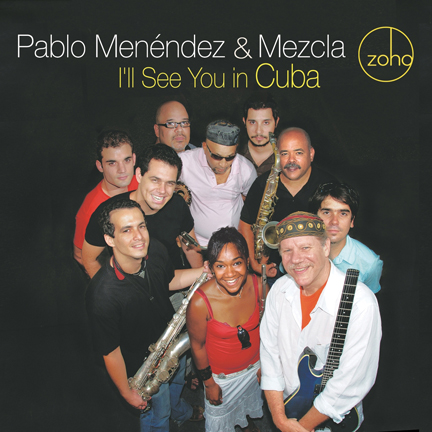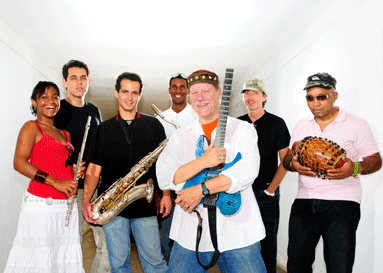|
Pablo Menendez & Mezcla
I'll See You In Cuba!
Release Date: January 11, 2010
Selection #: ZM 201001
UPC Code: 880956100128
Availability: Worldwide
Songs:
1. Big Brecker
2. Quien Tiene Ritmo?
3. El Medico de los Pianos
4. I’ll See You In Cuba
5. Chicoy’s Blues
6. Oslo
7. Chucho’s Blues
8. Round Midnight
9. Homenaje a Afro Cuba
10. Chicoy’s Son
|
Musicians:
Pablo Menéndez - guitar & vocals, director
Magela Herrera - flute, vocals, piano (on El Médico, ‘Round Midnight, C.U.B.A.)
Octavio Rodríguez - percussion
Máyquel González - trumpet, flugelhorn
Orlando Sánchez - tenor Sax (all solos)
Néstor Rodríguez - tenor sax (on Afro Cuba & Medico de los Pianos)
Ruy Adrián López-Nussa - drums ( on Big Brecker; El Medico; Oslo)
Oliver Valdés - drums (on Chicoy’s Blues; Chucho’s Blues)
Renier Mendoza - drums (on Afro-Cuba; ‘Round Midnight, C.U.B.A.; Afro Cuba)
Ernesto Hermida - bass (on Big Brecker; Chicoy’s Blues, Chucho’s Blues; El Médico; Quien tiene?)
José Hermida - bass (on Oslo; Afro-Cuba; ‘Round Midnight; C.U.B.A.)
Orlando Sánchez - piano (on Big Brecker, Oslo, Chucho’s Blues, Chicoy’s Blues)
Magela Herrera - piano
|
 |
|
For those who think Cuban music fits in a cigar box, who have Buena Vista vision, or a Ricky Ricardo fixation, for those who think that Cuban music is only Salsa, Timba, Mambo or Afro folkloric: this recording will challenge, rock, annoy you or all three. Either way you will be surprised by the incredible fluidity with which these musicians float between genres and worlds.
This ability comes from the genuine love affair band leader Pablo Menéndez has with music and with Cuba,which he sees as one of the world's great mixtures (mezclas) of cultures. Pablo, an American born in Oakland, is the son of blues and jazz singer Barbara Dane who was the first U.S. performer to visit and perform in Cuba after the 1959 Revolution. From birth he was surrounded by every kind of music, from American jazz, blues, bluegrass and gospel to West African, Eastern European and South American. At the end of Barbara's 1966 Cuba tour, she arranged for Pablo to study at Havana’s National School of Arts (Cubanacan) where he fell in love with and married classmate Adria Santana, who went on to become one of Cuba's greatest theater actresses. Pablo has been living in Havana since 1966 with his Cuban family.
Coming from the San Francisco Bay with its many bridges, it is only natural that Pablo himself has become a cultural bridge. This is a fundamental part of his identity. He is a happy transplant. Consequently, so are we, because Pablo shares with us his mastery of Cuban musical styles and genres, mixing them up through his virtuosic control of the guitar. His group Mezcla matches his fluency in many musical languages, as you will hear.
From guest musicians like Samuel Formell (of the incredible “Los Van Van”), Alejandro Vargas and others, to the formidable mainstays like saxophonist Orlando Sánchez, trumpeter Máyquel González, the multi-instrumentalist Magela Herrera, percussion master Octavio Rodríguez, the great trap drummers Ruy Adrian López-Nussa, Oliver Valdés and Renier Mendoza who share the chair and father / son bass players José and Ernesto Hermida, this is a fierce group of musical entities that must be acknowledged. They may not be household names in the United States, but they’re certainly capable of holding their own in such company.
Big Brecker is a loving tribute to Michael Brecker. It begins with a fast swing that transforms into a songo-ish guaguanco shuffle. The bridge has a light airy feel but the return of the A section is always hardcore fast and furious. Orlando matches the feel with a relentless, hard driving approach that reflects the profound respect Cuban saxophonists (actually all saxophonists) have for Michael. Máyquel reveals a unique forward-looking concept in his trumpet solo that does not let up.
¿Quién Tiene Ritmo? ("Who's Got Rhythm?", the tongue in cheek answer by Ben Lapidus of Sonido Isleño to George Gershwin's 1930 jazz standard "I've Got Rhythm") has a world-awareness vibe to its groove that makes it quintessentially Cuban and yet mysteriously planetary. It is a result of the opening ostinatos that play against the rootedness of the guiro beautifully played by Julio Noroña (also of "Los Van Van"). The opening flute sounds and resulting flute improvisation are remarkable in that they have a charanga (roots) vibe to them, but they don’t sound old fashioned and on the contrary, Magela Herrera sounds modern and hip. The percussion, drums and timbal solo are all soaked in authenticity, taste and groove.
There is a wonderful non-profit organization in the United States dedicated to sending pianos to Cuba. This organization "SEND A PIANA TO HAVANA" (www.sendapiana.com), run by a man named Benjamin Treuhaft, helps alleviate some of Cuba’s’ piano needs. Because of our silly embargo it has been hard to afford, let alone acquire world-class instruments there. This danzón, El Médico de los Pianos (“The Piano Doctor”) which later turns into a cha cha-ish vamp is dedicated to Ben. Besides her flute, on this tune, multi-tracking Magela gets a chance to show off her piano chops, too. Note the trumpet solo here, which is very modern, but respectful of our ancestral charanga/danzón roots. Very hip!
I’ll See You in C-U-B-A, an Irving Berlin song from the Prohibition Era, when alcohol --banned in the US-- was legal only 90 miles south of Florida. It's a tongue in cheek stab at what could very well happen when travel restrictions for American tourists get lifted and the island becomes a destination for vacationers from the States. Not necessarily a happy or unhappy picture, just one that acknowledges the need for Cuba to protect itself from silliness and profiteering by the travel mobs. The rhythmic setting and trumpet work reveal how chameleon-like these musicians can be, adopting any variety of setting to fulfill the musical agenda.
The guitar work in the beginning of Chicoy’s Blues is heartfelt, genuine and could pass for any great rock or blues guitarist, from Jeff Beck (who he reminds me of) to Larry Carlton whose stamp on Mr. Menéndez seems apparent. The blues form is unusual in that it is 16 measures long and uses some substitute chords. This gives it a bright modern sound with excellent work from Ernesto Hermida. This is definitely Blues, but with a modern edge.
I love the way this version of Oslo begins. The quirky sounds of the guitar, the beautiful effects-laden flute work of Magela, whose solo work sounds very different from her approach in "¿Quien Tiene Ritmo?". Here it reveals none of the charanga flavor and instead sounds very modern and harmonically sophisticated. The melody statement doubled by distorted guitar and tenor is very orchestral and the tenor solo by Orlando is forceful and in direct contrast to the flute approach.
|
 Irakere defined the sound that we associate with modern Cuban jazz, and here the allusion is clear. The melodic statement and accompanying funk jazz rhythms of Chucho’s Blues are fast, furious and funky, very influenced by the work of grandmaster Chucho Valdez. The bridge sections have a “Mercy, Mercy, Mercy” feel (the classic Joe Zawinul composition), but with a different harmonic take on the repeat that makes it contemporary. Every soloist shines here, but guest artist José Luis Pacheco is especially fluid in his interpretation of the pyrotechnical mastery that earmarks all of the Irakere musicians. Irakere defined the sound that we associate with modern Cuban jazz, and here the allusion is clear. The melodic statement and accompanying funk jazz rhythms of Chucho’s Blues are fast, furious and funky, very influenced by the work of grandmaster Chucho Valdez. The bridge sections have a “Mercy, Mercy, Mercy” feel (the classic Joe Zawinul composition), but with a different harmonic take on the repeat that makes it contemporary. Every soloist shines here, but guest artist José Luis Pacheco is especially fluid in his interpretation of the pyrotechnical mastery that earmarks all of the Irakere musicians.
Mezcla’s take on the Thelonius Monk classic ‘Round Midnight is based on a simple up-tempo bolero rhythm. It is in the blood of every Cuban musician to play this rhythm with groove and precision. They do not disappoint here. The guitar solo has a dreamy, blues-like approach to this venerated jazz classic that some might take exception to, but for me it is every bit as insightful as the traditional approach. Without limiting it to twelve bars or a strict format, 'Round Midnight is a blues of sorts. I dig the funkified montuno section and the ensuing guitar trumpet trades.
Homenaje a Afro Cuba has several things I love. This was my favorite piece on the recording for a number of reasons. The 6/8 rhythm that flirts with being a 3 -2 guaguancó that flirts with being in "two" is a specialty of Cuban rhythm sections that few have better command of. The melodic contours are just beautiful in the opening statements. The harmony is rich and contemporary, and the frontline of trumpet, flugelhorn and tenor is seamless. When the piece yields to Octavio Rodríguez, you realize what a master of folkloric styles he is. He is the real deal, and like the greats Candido, Patato and Chano, his is not a style based on histrionics and chops display. When the flugelhorns come in with their duo and ensuing trades and collective playing, it is dreamy; it is rich, passionate and pure Cuban soul.
Chicoy’s “Son" is a little studio fun, a punctuation mark that signals the end of a very satisfying musical journey. What we have here is two old friends, Pablo Menéndez and Emilio Martiní (Mr. Guitar Monster) having fun at the board and perhaps chuckling at the scope of their labor, at the variety of music, the multiplicity of skills and concepts represented on this CD.
I have had the privilege of visiting Cuba several times and can attest to the innate musicality and high technical level of most Cuban musicians, and the profound knowledge of the musical traditions that most are aware of. What we haven't talked about is the sheer joy of just making music. For the vast majority, there is no big label contract at the end of the rainbow, no pot of gold, no real chance of stardom (whatever that means). They do what they do, not for career, or money or fame, they do it for the sheer love of playing music the best they can. I think that comes across beautifully in this record.
I also had the privilege of visiting Pablo at his home and meeting all these fine artists. They are also great, gracious and generous people. One doesn’t get that holier than thou, separate from others, serious “jazz” musician vibe that can be so unnecessary and off-putting. They play with so much joy! Maybe that's because they haven't had to learn the concept of a "day job" and because everyone around them assumes that music, not chasing money or fame, is their life!
Pablo has created a family of like-minded artists down in Havana, an informed, multicultural and open family whose sole desire is to play great music, mindful of their roots, ever looking forward and always joyful: a real “mezcla” (mix).
Arturo O’Farrill
Produced and arranged by Pablo Menéndez. Basic tracks recorded by Lucía Huergo. Additional recording by Pablo Menéndez, Alexei Morejón
Mix: Emilio Martiní (Mr. Guitar Monster!) 2009. Photos: Roxana González. Package design by Al Gold. Executive Producer: Joachim “Jochen” Becker.
|
|
|
|

